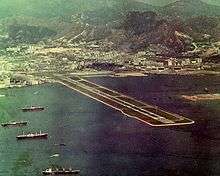Thai Airways International Flight 601
 A Thai Airways International SUD-Aviation Caravelle similar to the one involved. | |
| Accident summary | |
|---|---|
| Date | 30 June 1967 |
| Summary | Landing accident |
| Site |
near Kai Tak Airport, Hong Kong 22°18′07″N 114°13′02″E / 22.3020°N 114.2173°ECoordinates: 22°18′07″N 114°13′02″E / 22.3020°N 114.2173°E |
| Passengers | 73 |
| Crew | 7 |
| Fatalities | 24 |
| Injuries (non-fatal) | 56 |
| Survivors | 56 |
| Aircraft type | Sud Aviation Caravelle III |
| Aircraft name | Chiraprapa |
| Operator | Thai Airways International |
| Registration | HS-TGI |
| Flight origin | Taipei Songshan Airport |
| Destination | Kai Tak Airport |
Thai Airways International Flight 601 was a Sud Aviation Caravelle that crashed into the sea on landing at the former Kai Tak Airport, Hong Kong, in a typhoon on 30 July 1967.
Accident
Thai Airways International Flight 601 took off from Taipei Songshan Airport (TSA/RCSS) on a flight to Kai Tak Airport. The Sud Aviation Caravelle (Registration: HS-TGI which had its first flight in 1960) had 73 passengers and 7 crew on board and after a 1 hour flight was on an ILS approach to land on runway 31 at Hong Kong-Kai Tak International Airport (HKG/VHHH). With a typhoon over Hong Kong at the time of the approach, the Captain was busy looking for visual contact with the ground not noticing that the aircraft had descended below the decision height of 415 feet (126 m). The aircraft made an abrupt heading change (while already 80 feet (24 m) below the glide slope), then entered a high rate of descent and crashed into the sea short of runway 31 under-shoot. The accident killed 24 passengers out of 80 passengers and crew on board.

Probable cause
The probable cause of the accident was crew error, not noticing that was aircraft descended below the glide slope. The presence of strong wind shear and downdrafts is also a probable major factor, however at the time of the accident there was no means of measuring these phenomena available at Kai Tak.
- The pilots did not adhere to the Thai Airways procedure for a 'captain monitored' approach in bad visibility.
- The captain did not monitor the approach adequately.
- The abrupt heading change after the aircraft descended below minimum altitude may have exacerbated a high rate of descent.
- Downdrafts and wind shear may have contributed to the height loss which resulted from this mishandling.
References
- Accident description for HS-TGI at the Aviation Safety Network. Retrieved on 12 July 2013.